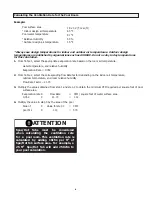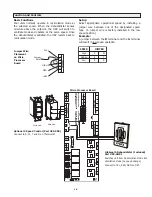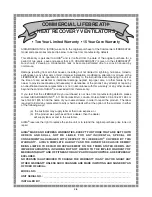
It is necessary to have balanced air flows in an HRV. The volume of air
brought in from the outside must equal the volume of air exhausted by
the unit. If the air flows are not properly balanced, then;
•
The HRV may not operate at its maximum efficiency
•
A negative or positive air pressure may occur
in the building
•
The unit may not defrost properly
•
Failure to balance HRV properly may void warranty
Excessive
positive
pressure
may drive moist indoor air into the
external walls of the building where it may condense (in cold
weather) and degrade structural components. May also cause key
holes to freeze up.
Excessive
negative
pressure
may have several undesirable
effects. In some geographic locations, soil gases such as methane
and radon gas may be drawn into the home through
basement/ground contact areas. Excessive negative pressure may
also cause the backdrafting of vented combustion equipment.
Read
the
Application
Warning
on
the
front
of
this
manual!
Prior
to
balancing,
ensure
that:
1. All sealing of the ductwork system has been completed.
2. All of the HRV's components are in place and functioning properly.
3. Balancing dampers are fully open.
4. Unit is on HIGH speed.
5. Air flows in branch lines to specific areas of the house should be
adjusted first prior to balancing the unit. A smoke pencil used at
the grilles is a good indicator of each branch line's relative air
flow.
6. After taking readings of both the stale air to the HRV duct and
fresh air to the house duct, the duct with the lower CFM ([L/
s] velocity) reading should be left alone, while the duct with the
higher reading should be adjusted back to match the lower read-
ing. See
Adjusting
the
Airflow
.
7. Return unit to appropriate fan speed for normal operation
BALANCING
PROCEDURE
The following is a method of field balancing an HRV using a Pitot
tube, advantageous in situations when flow stations are not installed
in the ductwork. Procedure should be performed with the HRV on high
speed.
The first step is to operate
all
mechanical systems on high speed,
which have an influence on the ventilation system, i.e. the HRV
itself and the forced air furnace or air handler if applicable. This will
provide the maximum pressure that the HRV will need to overcome,
and allow for a more accurate balance of the unit.
Drill a small hole in the duct (about 3/16"), three feet
downstream of any elbows or bends, and one foot
upstream of any elbows or bends. These are
recommended distances but the actual installation
may limit the amount of straight duct.
The Pitot tube should be connected to a
manometer capable of reading 3 digits of
resolution. The tube coming out of the top of
the pitot is connected to the high pressure side of
the gauge. The tube coming out of the side of the
pitot is connected to the low pressure or reference
side of the gauge.
I
nsert the Pitot tube into the duct; pointing the tip
into the airflow.
For general balancing it is sufficient to move the pitot tube around
in the duct and take an average or typical reading. Repeat this
procedure in the other (supply or return) duct. Determine which
duct has the highest airflow (highest reading on the manometer).
Adjust the higher airflow by reducing the fan speed (see
“Adjusting the Airflow”). The flows should now be balanced.
Actual airflow can be determined from the gauge reading. The
value read on the gauge is called the velocity pressure. The Pitot
tube comes with a chart that will give the air flow velocity based
on the velocity pressure indicated by the gauge. This velocity will
be in either feet per minute or meters per second. To determine
the actual airflow, the velocity is multiplied by the cross sectional
area of the duct being measured.
This is an example for determining the airflow in a 6" duct.
The Pitot tube reading was 0.025 inches of water.
From the chart, this is 640 feet per minute.
The 6" duct has a cross sectional area of
= [3.14 x (6"÷12)
2
]÷4
= 0.2 square feet
The airflow is then:
640 ft./min. X 0.2 square feet = 128 cfm
For your convenience, the cross sectional area of some common round duct
is listed below:
DUCT
DIAM.
(inches)
5 (127 mm)
6 (152 mm)
7 (178 mm)
CROSS
SECTION
AREA
(sq. ft.)
0.14
0.20
0.27
The accuracy of the air flow reading will be affected by how close to
any elbows or bends the readings are taken. Accuracy can be
increased by taking an average of multiple readings as outlined in the
literature supplied with the Pitot tube.
DUCT
AIR
FLOW
Pitot tube
Digital manometer
Pitot
tube
and
gauge
Place pitot tube a minimum
of 18"
from
blower or
elbows
Note:
Duct
connections may vary,
depending on model.
Outdoors
Pitot
tube
Pitot
tube
Pitot
Tube
Air
Flow
Balancing
-
Commercial
Pitot
Tube
Air
Flow
Balancing
Kit
c/w digital manometer,
Pitot tube, hose and tool
bag.
PART NO. 99-BAL-KIT
Digital Manometer
2
0
Summary of Contents for 1200 POOL
Page 27: ...27 Wiring Diagram Models 700 1200 POOL ...
Page 29: ...29 ...
Page 30: ...30 ...
Page 31: ...31 ...
Page 32: ...info lifebreath com T 1 855 247 4200 F 1 800 494 4185 69 POOL 100516 ...













































